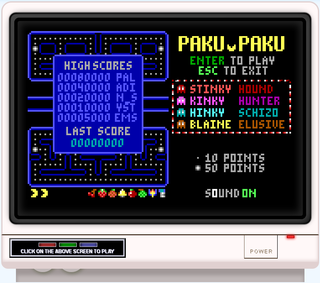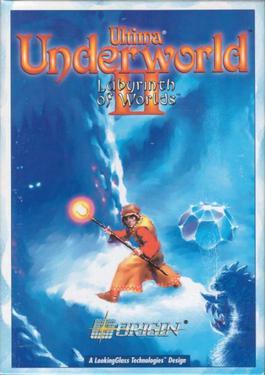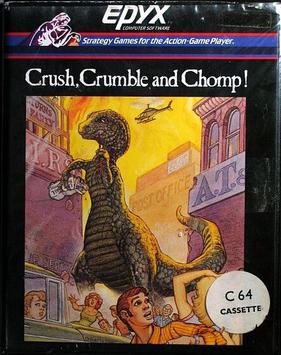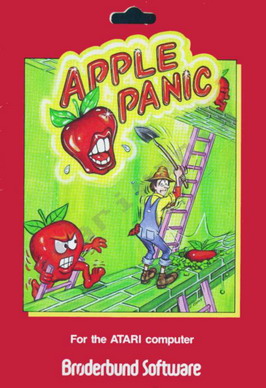
A platformer is a sub-genre of action video games in which the core objective is to move the player character between points in an environment. Platform games are characterized by levels with uneven terrain and suspended platforms of varying height that require jumping and climbing to traverse. Other acrobatic maneuvers may factor into the gameplay, such as swinging from vines or grappling hooks, jumping off walls, gliding through the air, or bouncing from springboards or trampolines.

Zork is a text adventure game first released in 1977 by developers Tim Anderson, Marc Blank, Bruce Daniels, and Dave Lebling for the PDP-10 mainframe computer. The original developers and others, as the company Infocom, expanded and split the game into three titles—Zork I: The Great Underground Empire, Zork II: The Wizard of Frobozz, and Zork III: The Dungeon Master—which were released commercially for a range of personal computers beginning in 1980. In Zork, the player explores the abandoned Great Underground Empire in search of treasure. The player moves between the game's hundreds of locations and interacts with objects by typing commands in natural language that the game interprets. The program acts as a narrator, describing the player's location and the results of the player's commands. It has been described as the most famous piece of interactive fiction.
The Adventure Game Interpreter (AGI) is a game engine developed by Sierra On-Line. The company originally developed the engine for King's Quest (1984), an adventure game that Sierra and IBM wished to market in order to attract consumers to IBM's lower-cost home computer, the IBM PCjr.

Temple of Apshai is a dungeon crawl role-playing video game developed and published by Automated Simulations in 1979. Originating on the TRS-80 and Commodore PET, it was followed by several updated versions for other computers between 1980 and 1986.
1982 was the peak year for the golden age of arcade video games as well as the second generation of video game consoles. Many games were released that would spawn franchises, or at least sequels, including Dig Dug, Pole Position, Mr. Do!, Zaxxon, Q*bert, Time Pilot and Pitfall! The year's highest-grossing video game was Namco's arcade game Pac-Man, for the third year in a row, while the year's best-selling home system was the Atari 2600. Additional video game consoles added to a crowded market, notably the ColecoVision and Atari 5200. Troubles at Atari late in the year triggered the video game crash of 1983.

A personal computer game, also known as a computer game or abbreviated PC game, is a video game played on a personal computer (PC).

Ultima Underworld II: Labyrinth of Worlds is a 1993 first-person role-playing video game developed by LookingGlass Technologies and published by Origin Systems. As the sequel to Ultima Underworld: The Stygian Abyss, the game is set in the Ultima fantasy universe. Players assume the role of the Avatar—the protagonist of the Ultima series—and adventure through multiple dimensions while seeking to prevent the evil Guardian from achieving world domination. Progression is largely nonlinear and the game allows for emergent gameplay.

Crush, Crumble and Chomp! is a video game where the player takes control of a movie monster and attacks a major city, such as New York or San Francisco. It was published in 1981 for the TRS-80, Apple II, and Atari 8-bit computers. Ports to the VIC-20, Commodore 64, and IBM PC compatibles were released later. Some versions were published under the company's original name of Automated Simulations, while the rest use Epyx.

Apple Panic is a game for the Apple II programmed by Ben Serki and published by Broderbund Software in 1981. Apple Panic is an unauthorized version of the 1980 arcade game Space Panic, the first game with ladders and platforms. While the arcade original remained obscure, Apple Panic became a top seller for home computers. It was ported to the Atari 8-bit computers, VIC-20, IBM PC, and TRS-80.

Time Bandit is a maze shoot 'em up written for the TRS-80 Model I by Bill Dunlevy and Harry Lafnear and published by MichTron in 1983. It was ported to the TRS-80 Color Computer and Dragon 32, but enjoyed its greatest popularity several years later as an early release for the Atari ST. It was also released for the pseudo-PC-compatible Sanyo MBC-55x with 8-color display. Amiga and MS-DOS versions were ported by Timothy Purves.

Dungeons of Daggorath is one of the first real-time, first-person perspective role-playing video games. It was produced by DynaMicro for the TRS-80 Color Computer in 1983. A sequel, Castle of Tharoggad, was released in 1988.

In video games, first-person is any graphical perspective rendered from the viewpoint of the player character, or from the inside of a device or vehicle controlled by the player character. It is one of two perspectives used in the vast majority of video games, with the other being third-person, the graphical perspective from outside of any character ; some games such as interactive fiction do not belong to either format.

A first-person shooter (FPS) is a video game centered on gun fighting and other weapon-based combat seen from a first-person perspective, with the player experiencing the action directly through the eyes of the main character. This genre shares multiple common traits with other shooter games, and in turn falls under the action games category. Since the genre's inception, advanced 3D and pseudo-3D graphics have proven fundamental to allow a reasonable level of immersion in the game world, and this type of game helped pushing technology progressively further, challenging hardware developers worldwide to introduce numerous innovations in the field of graphics processing units. Multiplayer gaming has been an integral part of the experience, and became even more prominent with the diffusion of internet connectivity in recent years.

Olympic Decathlon is a sports video game written by Timothy W. Smith for the TRS-80 and published in 1980 by Microsoft. In the game, the player competes in ten track and field events. The gold medalist for decathlon in the Montreal 1976 Summer Olympics, Caitlyn Jenner, is a character. It was ported to the Apple II in 1981. The 1982 version for the IBM PC was renamed Microsoft Decathlon.
Arsys Software (アルシスソフトウェア), later known as Cyberhead (サイバーヘッド), was a Japanese video game software development company active from 1985 to 2001.

Microsoft Adventure is a interactive fiction game published in 1979 by Microsoft for the TRS-80 and Apple II, then released in 1981 by IBM for the IBM PC. It is based on the PDP-10 mainframe game Colossal Cave Adventure. It was programmed for Microsoft by Gordon Letwin of Softwin Associates.

FS1 Flight Simulator is a 1979 video game published by Sublogic for the Apple II. A TRS-80 version followed in 1980. FS1 is the first in a line of simulations from Sublogic which, beginning in 1982, were also sold by Microsoft as Microsoft Flight Simulator.
Med Systems Software was a company that produced video games for home computers in the early 1980s. In 1983, the company name was changed to Screenplay.













